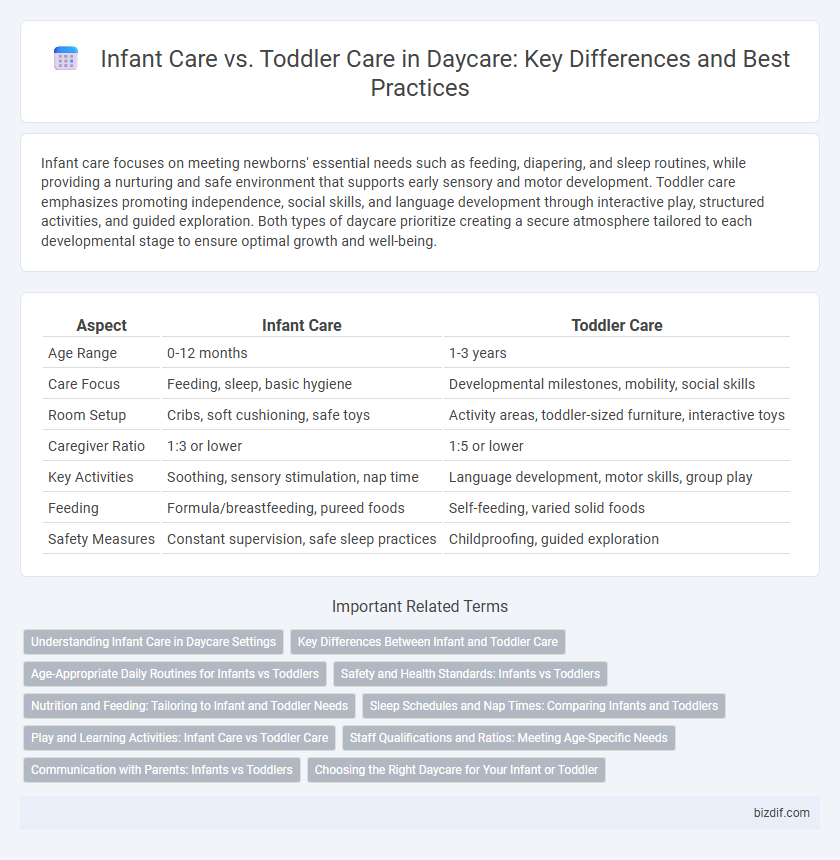Infant care focuses on meeting newborns' essential needs such as feeding, diapering, and sleep routines, while providing a nurturing and safe environment that supports early sensory and motor development. Toddler care emphasizes promoting independence, social skills, and language development through interactive play, structured activities, and guided exploration. Both types of daycare prioritize creating a secure atmosphere tailored to each developmental stage to ensure optimal growth and well-being.
Table of Comparison
| Aspect | Infant Care | Toddler Care |
|---|---|---|
| Age Range | 0-12 months | 1-3 years |
| Care Focus | Feeding, sleep, basic hygiene | Developmental milestones, mobility, social skills |
| Room Setup | Cribs, soft cushioning, safe toys | Activity areas, toddler-sized furniture, interactive toys |
| Caregiver Ratio | 1:3 or lower | 1:5 or lower |
| Key Activities | Soothing, sensory stimulation, nap time | Language development, motor skills, group play |
| Feeding | Formula/breastfeeding, pureed foods | Self-feeding, varied solid foods |
| Safety Measures | Constant supervision, safe sleep practices | Childproofing, guided exploration |
Understanding Infant Care in Daycare Settings
Infant care in daycare settings emphasizes creating a safe, nurturing environment tailored to the unique developmental needs of babies aged 6 weeks to 12 months. Key aspects include individualized feeding schedules, diapering routines, and soothing techniques to support healthy attachment and cognitive growth. Caregivers are trained to monitor sleep patterns, sensory stimulation, and motor skill development while ensuring consistent communication with parents about the infant's daily progress.
Key Differences Between Infant and Toddler Care
Infant care primarily focuses on feeding, diapering, and ensuring safe sleep environments, while toddler care emphasizes developing motor skills, language acquisition, and social interactions. Caregivers for infants must provide constant supervision and comfort due to infants' dependency, whereas toddler care involves structured activities that promote independence and cognitive growth. Safety measures differ as infants require protection from sudden infant death syndrome (SIDS), whereas toddler safety concerns revolve around preventing falls and managing increased mobility.
Age-Appropriate Daily Routines for Infants vs Toddlers
Infant care routines prioritize frequent feeding, diaper changes, and extensive nap times, tailored to newborns up to 12 months to support rapid growth and development. Toddler care schedules emphasize structured play, social interaction, and consistent meal and potty-training times for children aged 1 to 3 years, fostering independence and motor skills. Both routines require caregivers to adapt activities and supervision levels according to developmental milestones within each age group.
Safety and Health Standards: Infants vs Toddlers
Infant care requires strict adherence to safety protocols such as safe sleep practices, constant supervision, and infection control to protect their developing immune systems. Toddler care emphasizes injury prevention through childproofing environments and encouraging supervised exploration while maintaining hygiene standards to reduce illness transmission. Both age groups benefit from tailored health policies, but infants demand more intensive monitoring due to their vulnerability to sudden infant death syndrome (SIDS) and respiratory infections.
Nutrition and Feeding: Tailoring to Infant and Toddler Needs
Infant care in daycare emphasizes breast milk or formula feeding on demand, ensuring proper development through frequent, small meals rich in essential nutrients like DHA and iron. Toddler care shifts to a balanced diet with diverse solid foods, including fruits, vegetables, protein, and whole grains, promoting autonomy with self-feeding and portion control. Tailoring nutrition and feeding practices to these age-specific needs supports optimal growth, digestion, and immune health in both infants and toddlers.
Sleep Schedules and Nap Times: Comparing Infants and Toddlers
Infant care typically involves shorter, more frequent naps totaling 14 to 17 hours of sleep per day, with sleep patterns that are often irregular and influenced by feeding schedules. Toddler care requires more structured sleep schedules, generally including one to two naps lasting 1 to 3 hours, with nighttime sleep averaging 11 to 14 hours. Caregivers must adapt routines to support developmental changes, ensuring infants receive restful sleep for brain growth while toddlers benefit from consistent nap times to foster emotional regulation and physical activity.
Play and Learning Activities: Infant Care vs Toddler Care
Infant care centers on sensory play and motor skill development, incorporating activities like tummy time and soft toy interaction that stimulate cognitive growth and early communication. Toddler care emphasizes more structured play involving puzzles, building blocks, and imaginative role-playing that enhance language skills, problem-solving, and social interaction. Both stages prioritize age-appropriate learning environments tailored to developmental milestones to optimize engagement and skill acquisition.
Staff Qualifications and Ratios: Meeting Age-Specific Needs
Infant care demands a higher staff-to-child ratio, typically 1:3 or lower, ensuring close supervision and individualized attention from caregivers with specialized training in infant development and safety. Toddler care allows for a slightly larger ratio, often around 1:5, with staff skilled in managing increased mobility and early socialization while supporting developmental milestones. Qualified caregivers in both settings must hold certifications in pediatric first aid, CPR, and early childhood education to meet stringent regulatory standards and promote optimal growth.
Communication with Parents: Infants vs Toddlers
Infant care emphasizes frequent, detailed communication with parents about feeding schedules, sleep patterns, and early developmental milestones to ensure seamless continuity between home and daycare. Toddler care focuses on sharing updates about language development, social interactions, and emerging independence, providing parents with insights into their child's growing skills and behavior. Clear, consistent communication tailored to each stage promotes trust and supports the child's overall development in both infant and toddler care settings.
Choosing the Right Daycare for Your Infant or Toddler
Choosing the right daycare for your infant or toddler involves understanding the distinct developmental needs of each age group, such as nurturing sensory exploration for infants and promoting social skills for toddlers. Prioritize facilities with qualified caregivers trained in age-specific developmental milestones and safe, engaging environments tailored to your child's stage. Evaluating caregiver-to-child ratios, cleanliness, and curriculum allows parents to make an informed decision that supports their child's early growth and well-being.
Infant care vs Toddler care Infographic

 bizdif.com
bizdif.com